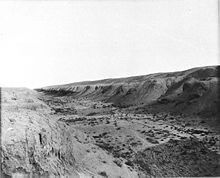Nahrawan Canal
The Nahrawan Canal was the largest ancient canal in the Middle East. It ran along the Tigris near Ctesiphon .
The Nahrawan Canal dates back to the 3rd century AD and was 400 km long and its route varied in width from 30 m to 122 m. It reached from the Tigris near Samarra to the Diyala . The Tigris was dammed by Nimrod's dam and diverted into the canal.
The photographer Gertrude Bell documented the canal bed that had fallen dry in 1909.
The Nahrawan Canal gained historical importance because it acted as an artificial geographical obstacle in February 628, preventing Herakleios from reaching Ctesiphon. This stopped Herakleios kilometers from the city of Ctesiphon .
Web links
- International Canal Monuments List of the International Council on Monuments and Sites (PDF file; 272 kB)
literature
- James Felix Jones (Ed.): Memoirs of Baghdad, Kurdistan and Turkish Arabia. Selections from the records of the Bombay Government, No. XLIII, New Series . Facsimile of edition published Bombay, 1857. Archive Editions, Slough 1998, ISBN 1-85207-099-4 .
